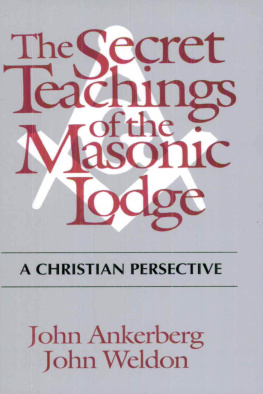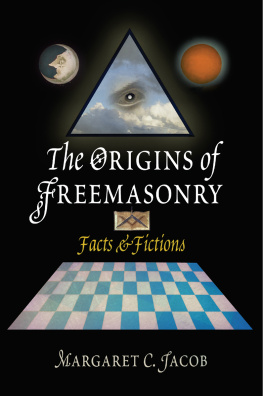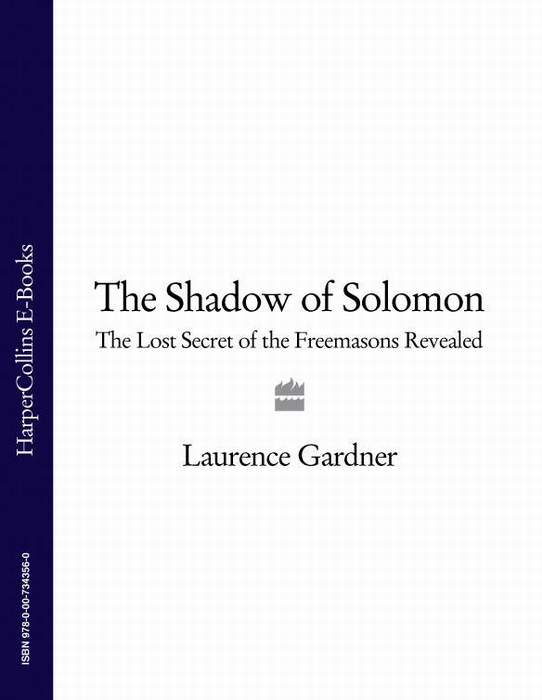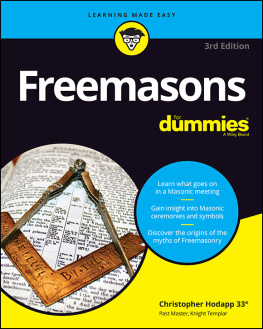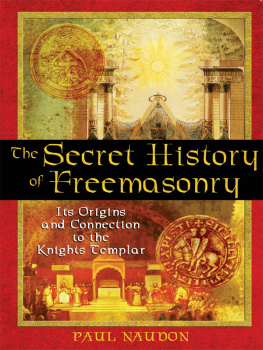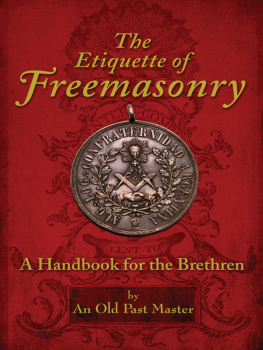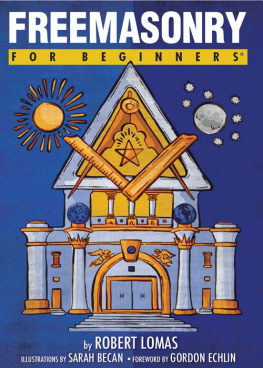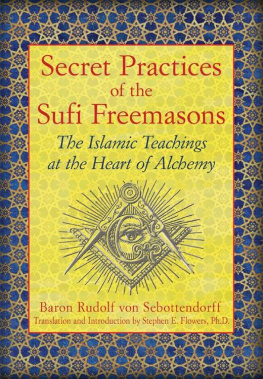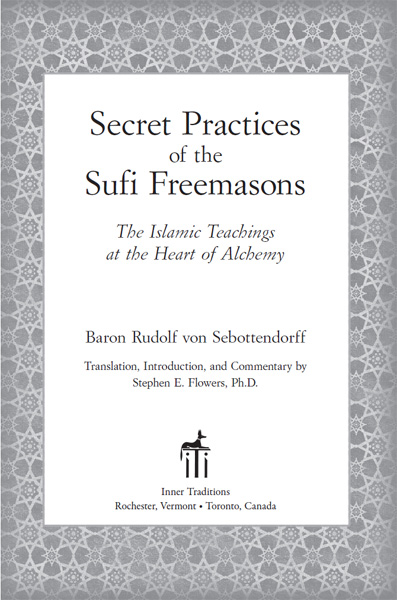Dedicated to the Memory of the Former Secretaryof the Turkish Embassy in Bern,Mr. P. Schwidtal
Introduction
You have before you a very strange book. It is a book of secret Sufi exercises based on a particular sects teachings about certain sounds, gestures, and the so-called abbreviated letters found at the beginnings of certain chapters of the Quran. These exercises are reputed to be able to perfect the spirit of the individual. Furthermore, this particular book was written by a German expatriate and Turkish citizen, who is reputed by some to be the mastermind behind the formation of a political order that eventually became Hitlers Nazis. You have been warned that you are embarking on a strange adventure.
The text of the 1924 book titled Die Praxis der alten trkischen Freimauerei (The Practice of Ancient Turkish Freemasonry) is in itself unusual. Part of its content is well organized, clear, and concise; while other features of it are mixed with elements of a confusing and chaotic nature. The manual could have been even shorter. It really consists simply of a description and schedule of exercises to be conducted regularly over a period of many months. No concrete knowledge is imparted as to what these exercises will actually do for the individualbut it is clearly implied that the reward will be great and that all sorts of knowledge and wisdom will be imparted directly to the practitioner.
This book is intended to be nothing more than a translation of Sebottendorffs 1924 text with some explanatory information about the author, his ideas, and the general spiritual world that gave rise to the exercises. It is not an attempt to add anything new or different to the text, which stands on its own.
I am not a Muslim or a teacher of Sufism. I am just a humble scholar. No insult, slight, or disrespect is ever intended toward Muhammad, the Quran, or Islam. On the contrary, it is hoped that this book will open the eyes of a few more people to the great spiritual contributions of Islam to the mysterious world we all share in common.
STEPHEN E. FLOWERS
WOODHARROW
The Life of Rudolf von Sebottendorff
Rudolf von Sebottendorff was a man of mystery. Much remains unknown about his life and his death. He is shrouded in legend and surrounded by misinformation. The true nature and motive of his life and work remain in question. That much of this obscurity was of his own manufacture is one thing that seems certain. The answers to these questions about the author of Secret Practices of the Sufi Freemasons may or may not be relevant to the understanding of the book you have before you. It may be that he simply acted as a conduit for these Sufi techniques to make their way into the West. This is at least part of what he seems to want to imply to the reader. Or it may be that his work in Germany after World War Iwork that most people today would deem sinisterwas a fundamental part of something intimately connected to the contents of The Secret Practices of the Sufi Freemasons. It seems most likely that the former is the truer of the two possibilities. The exercises were learned by Sebottendorff as part of his work with the Bektashi Order of dervishes in Istanbul. These and similar practices of Muslim orders, sects, and brotherhoods were seen by him to be essential in the age-old sense of solidarity and dedication to purpose inherent in these orders. These were qualities he wanted to re-instill in the German people (as he mentions in the text). Therefore, it is possible that the contents of the manual are not tainted with Sebottendorffs German nationalism; rather he simply wished to utilize the Sufi teachings in an attempt to regenerate German solidarity and dedication to purpose in the dismal time between the wars. In any event, the fascination this book has held for people over the years has stemmed more from the identity of its author than from the contents of the exercises. In this volume I wish to reorient attention to the substance of the Sufi practices, and away from the personality of the author. However, the fascinating and important story of the mysterious authors life cannot go unmentioned.
The first mystery of Baron Rudolf von Sebottendorffs life lies in the fact that he was not born a baron, nor was his name Sebottendorff. He obtained the name and title later in life. He was born Adam Alfred Rudolf Glauer in Hoyerswerda, near Dresden, on November 9, 1875. His father was a locomotive driver and veteran of the Prussian army, who fought in the Austro-Prussian campaign (1866) and the Franco-Prussian War (1871). Rudolfs father died in 1893 leaving enough money for his son to finish his formal education.
Glauer began training as a mechanical engineer, but never finished his studies. Instead he lived a life of adventure in exotic locales and on the high seas until 1900. In Australia, after attempting to prospect for gold, he received a letter of introduction from a Parsi (Zoroastrian) to a wealthy Turkish landowner, Hussain Pasha. He managed an estate at Bursa for this landowner, who was a practitioner of Sufism. He was also introduced there to the Termudi family. The patriarch of this Jewish family, originally from Greece, was a student of the Kabbalah and Rosicrucianism. Glauer was initiated into a Freemasonic lodge of which the Termudis were members. He remained in Turkey, learned Turkish, and studied occultism until 1902. Then he returned to Germany, but around 1908 some legal misadventures in Germany caused him to return to Turkey.
The next two years were pivotal for the adventurer. In 1910 he founded a mystical lodge in Constantinoplewhich is a tariqat of the Bektashi Order of Sufis. The next year he is legally adopted by the German expatriate Heinrich von Sebottendorff and also becomes a legal citizen of Turkey. This adoption was later repeated twice more by other Sebottendorff family members, all of which indicates just how important the acquisition of the noble title was to him.
During the Balkan War (19121913) he was on duty with the Red Crescent, the Islamic version of the Red Cross. He was actually wounded in battle and for a time a POW. After this he returned once more to Europe and lived in Berlin and Austria.
It was in the midst of the First World War (19141918) that Sebottendorff joined the Germanen Order (GO), at first by correspondence only. In September of 1916 he personally visited Hermann Pohl, who was the head of the order in Berlin. Subsequently Sebottendorff was elected master of the Bavarian province of the order and became the publisher of the GO publications.
The true nature and scope of the Germanen Order remains shadowy. Ostensibly it was formed as a sort of mystical lodge within the more politically oriented Reichshammerbund (Imperial Hammer League). The mastermind behind these groups was the notorious anti-Semite Theodor Fritsch (18521933).
As 1918 was drawing to a close, the fortunes of war and politics had turned against the Germans. The Great War was being lost and in Munich left-wing revolutionaries were clamoring for political power, inspired by recent success in the Russian Revolution (1917). The name Thule-Gesellschaft (Thule Society) was adopted by the Germanen Order as a cover identity. The society met weekly in rented rooms at the Hotel Vierjahreszeiten (Four Seasons) in Munich. But it began to take on a life and identity of its own under Sebottendorffs leadership. Occult topics were the subject of lectures given by the baronthis in the midst of open revolution in the streets of Munich.
Sebottendorff only led the Thule Society from April 1918 to July 1919. During this time he formed a militia to fight the Communists, was instrumental in the formation of the German Workers Party, and acquired a newspaper, the


